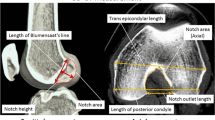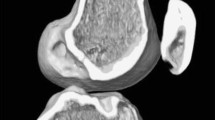Abstract
It is difficult to precisely identify the locations of tunnels after double-bundle anterior cruciate ligament (ACL) reconstruction postoperatively. Using our novel transparent 3-dimensional computed tomography (T-3DCT), we evaluated intra-articular outlet locations and the angles of the anteromedial (AM) and posterolateral (PL) tunnels after anatomic double-bundle ACL reconstruction using the trans-tibial technique. A prospective study was performed with 123 consecutive patients. Tunnel outlet locations were identified on T-3DCT images showing the true lateral view of the femur and indicated by our originally defined X, Y coordinates. We also determined the angles between the tunnel axis and a joint surface line in the coronal plane, the long axis of the femur in the sagittal plane, and the posterior condyle line in the axial plane of both the femur and the tibia. The mean X, Y coordinates of the AM and PL tunnel outlets were 21, 43% and 0, 33%, respectively. In the coronal, sagittal, and axial planes, the mean AM femoral tunnel angles were 63°, 48°, and 55°, respectively; the mean AM tibial tunnel angles in the tibia were 63°, 49°, and 71°, respectively; the mean PL femoral tunnel angles were 38°, 58°, and 43°, respectively; and the mean PL tibial tunnel angles were 46°, 53°, and 45°, respectively. The AM and PL tunnel outlets and angles could be detailed precisely in three dimensions by using T-3DCT. This imaging technique may be useful to confirm surgical techniques and to improve clinical outcomes.




Similar content being viewed by others
References
Ahn JH, Lee SH, Yoo JC, Ha HC (2007) Measurement of the graft angles for the anterior cruciate ligament reconstruction with transtibial technique using postoperative magnetic resonance imaging in comparative study. Knee Surg Sports Traumatol Arthrosc 15:1293–1300
Adachi N, Ochi M, Uchio Y, Iwasa J, Kuriwaka M, Ito Y (2004) Reconstruction of the anterior cruciate ligament. Single- versus double-bundle multistranded hamstring tendons. J Bone Joint Surg Br 86:515–520
Aglietti P, Giron F, Cuomo P, Losco M, Mondanelli N (2007) Single- and double-incision double-bundle ACL reconstruction. Clin Orthop Relat Res 454:108–113
Bernard M, Hertel P, Hornung H et al (1997) Femoral insertion of the ACL. Radiographic quadrant method. Am J Knee Surg 10:14–21
Cole J, Brand JC Jr, Caborn DN, Johnson DL (2000) Radiographic analysis of femoral tunnel position in anterior cruciate ligament reconstruction. Am J Knee Surg 13:218–222
Fu FH, Shen W, Starman JS, Okeke N, Irrgang JJ (2008) Primary anatomic double-bundle anterior cruciate ligament reconstruction. Am J Sports Med 36:1263–1274
Georgoulis AD, Papadonikolakis A, Papageorgiou CD, Mitsou A, Stergiou N (2003) Three-dimensional tibiofemoral kinematics of the anterior cruciate ligament-deficient and reconstructed knee during walking. Am J Sports Med 31:75–79
Giron F, Cuomo P, Edwards A, Bull AM, Amis AA, Aglietti P (2007) Double-bundle “anatomic” anterior cruciate ligament reconstruction: a cadaveric study of tunnel positioning with a transtibial technique. Arthroscopy 23:7–13
Jarvela T (2007) Double-bundle versus single-bundle anterior cruciate ligament reconstruction: a prospective, randomize clinical study. Knee Surg Sports Traumatol Arthrosc 15:500–507
Kondo E, Yasuda K, Ichiyama H, Azuma C, Tohyama H (2007) Radiologic evaluation of femoral and tibial tunnels created with the transtibial tunnel technique for anatomic double-bundle anterior cruciate ligament reconstruction. Arthroscopy 23:869–876
Kondo E, Yasuda K et al (2008) Prospective clinical comparisons of anatomic double-bundle versus single-bundle anterior cruciate ligament reconstruction procedures in 328 consecutive patients. Am J Sports Med 36:1675–1687
Hamada M, Shino K, Horibe S et al (2001) Single- versus bi-socket anterior cruciate ligament reconstruction using autogenous multiple-stranded hamstring tendons with EndoButton femoral fixation: a prospective study. Arthroscopy 17:801–807
Mott HW (1983) Semitendinosus anatomic reconstruction for cruciate ligament insufficiency. Clin Orthop Relat Res 172:90–92
Muneta T, Koga H, Mochizuki T, Ju YJ, Hara K, Nimura A, Yagishita K, Sekiya I (2007) A prospective randomized study of 4-strand semitendinosus tendon anterior cruciate ligament reconstruction comparing single-bundle and double-bundle techniques. Arthroscopy 23:618–628
Musahl V, Plakseychuk A, VanScyoc A et al (2005) Varying femoral tunnels between the anatomical footprint and isometric positions: effect on kinematics of the anterior cruciate ligament-reconstructed knee. Am J Sports Med 33:712–718
Poellinger A, Scheffler S, Hamm B, Asbach P (2009) Magnetic resonance imaging of double-bundle anterior cruciate ligament reconstruction. Skeletal Radiol 38:309–315
Siebold R, Dehler C, Ellert T (2008) Prospective randomized comparison of double-bundle versus single-bundle anterior cruciate ligament reconstruction. Arthroscopy 24:137–145
Streich NA, Friedrich K, Gotterbarm T, Schmitt H (2008) Reconstruction of the ACL with a semitendinosus tendon graft: a prospective randomized single blinded comparison of double-bundle versus single-bundle technique in male athletes. Knee Surg Sports Traumatol Arthrosc 16:232–238
Tashman S, Kolowich P, Collon D, Anderson K, Anderst W (2006) Dynamic function of the ACL-reconstructed knee during running. Clin Orthop Relat Res 454:66–73
Tomita F, Haba H, Tazaki Y (2005) Relationship between the femoral tunnel placement using plane CT and the intra/post operative parameters in anterior cruciate ligament reconstruction. Kansetsukyo (J Jpn Arthrosc Assoc). 30:33–37
Woo SLY, Kanamori A, Zeminski J, Yagi M, Papageorgiou C, Fu FH (2002) The effectiveness of reconstruction of the anterior cruciate ligament with hamstrings and patellar tendon. J Bone Joint Surg Am 84:907–914
Yagi M, Kuroda R, Nagamune K, Yoshiya S, Kurosaka M (2007) Double-bundle ACL reconstruction can improve rotational stability. Clin Orthop Relat Res 454:100–107
Yasuda K, Ichiyama H, Kondo E, Miyatake S, Inoue M, Tanabe Y (2008) An in vivo biomechanical study on the tension-versus-knee flexion angle curves of 2 grafts in anatomic double-bundle anterior cruciate ligament reconstruction: effects of initial tension and internal tibial rotation. Arthroscopy 24:276–284
Yasuda K, Kondo E, Ichiyama H et al (2003) Anatomical reconstruction procedure for the anteromedial and posterolateral bundles of the anterior cruciate ligament. Kansetsukyo (J Jpn Arthrosc Assoc). 28:17–23
Yasuda K, Kondo E, Ichiyama H et al (2004) Anatomic reconstruction of the anteromedial and posterolateral bundles of the anterior cruciate ligament using hamstring tendon grafts. Arthroscopy 20:1015–1025
Yasuda K, Kondo E, Ichiyama H, Tanabe Y, Tohyama H (2005) Surgical and biomechanical concept of anatomic anterior cruciate ligament reconstruction. Oper Tech Orthop 15:96–102
Yasuda K, Kondo E, Ichiyama H, Tanabe Y, Tohyama H (2006) Clinical evaluation of anatomic double-bundle anterior cruciate ligament reconstruction procedure using hamstringtendon grafts: comparisons among 3 different procedures. Arthroscopy 22:240–251
Zantop T, Wellmann M, Fu FH, Petersen W (2008) Tunnel positioning of anteromedial and posterolateral bundles in anatomic anterior cruciate ligament reconstruction: anatomic and radiographic findings. Am J Sports Med 36:65–72
Zantop T, Diermann N, Schumacher T, Schanz S, Fu FH, Petersen W (2008) Anatomical and nonanatomical double-bundle anterior cruciate ligament reconstruction: importance of femoral tunnel location on knee kinematics. Am J Sports Med 36:678–685
Author information
Authors and Affiliations
Corresponding author
Rights and permissions
About this article
Cite this article
Inoue, M., Tokuyasu, S., Kuwahara, S. et al. Tunnel location in transparent 3-dimensional CT in anatomic double-bundle anterior cruciate ligament reconstruction with the trans-tibial tunnel technique. Knee Surg Sports Traumatol Arthrosc 18, 1176–1183 (2010). https://doi.org/10.1007/s00167-009-0989-4
Received:
Accepted:
Published:
Issue Date:
DOI: https://doi.org/10.1007/s00167-009-0989-4




